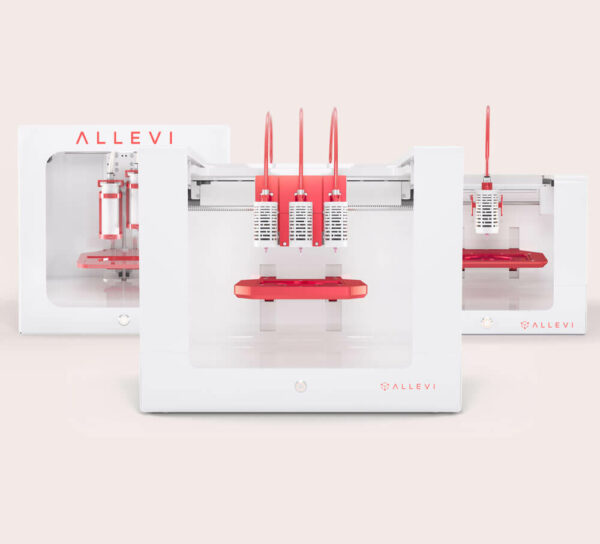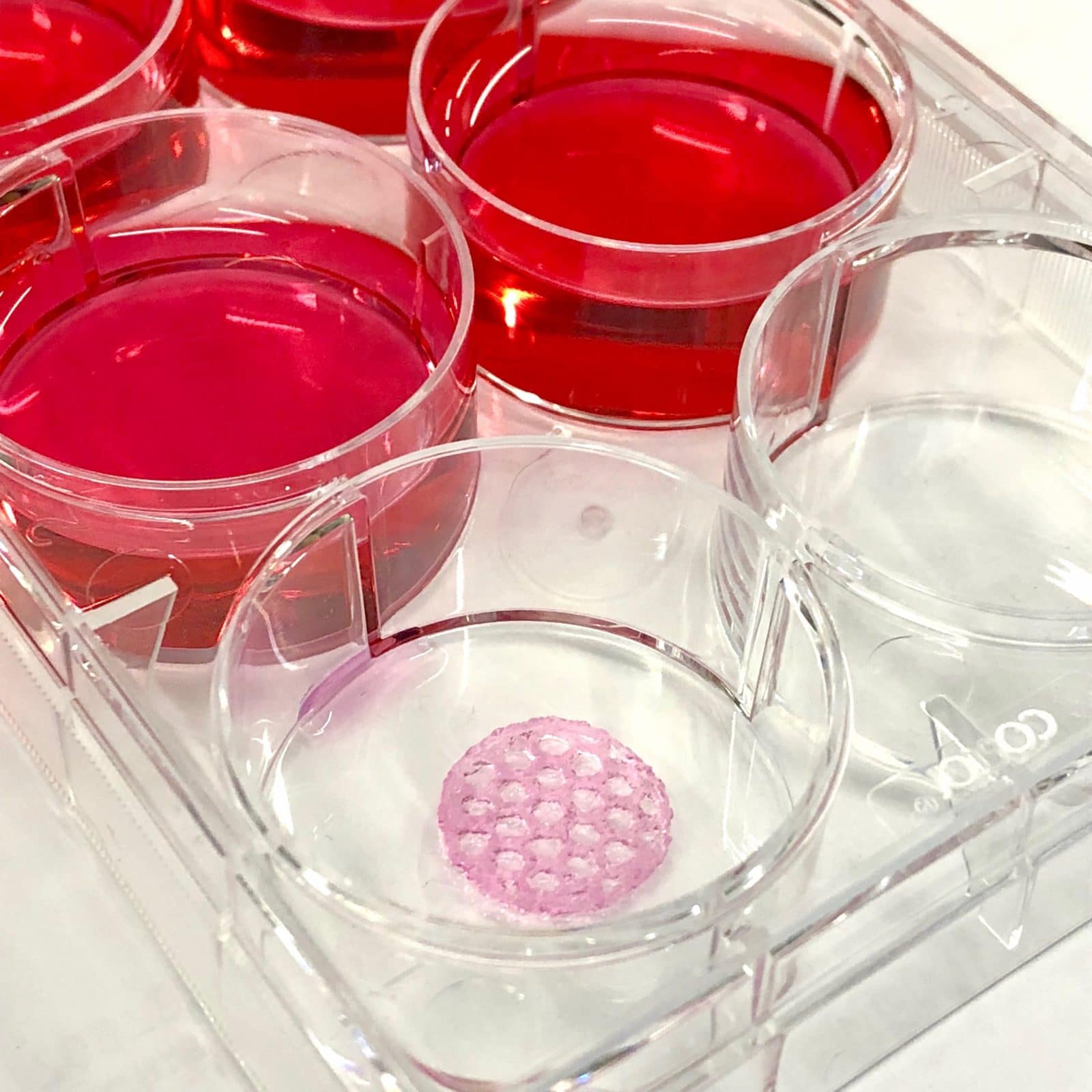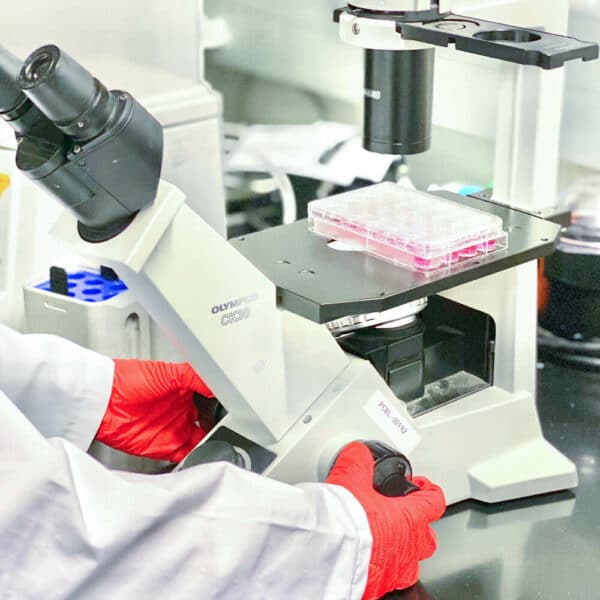

Overview
Materials
- GelMA
- LAP (or photoinitiator of choice)
- Amber or aluminum foil wrapped glass container
- PBS, water, or cell media (make sure to use a buffered solution if encapsulating cells)
- Plastic syringe (5mL or 10 mL)
- Petri dish or well plate for printing
- 0.22 µm Luer-Lock Sterile filter
- Syringe coupler
Methods
- Weigh the amount of LAP that corresponds to a final concentration of 0.5% w/v into a conical tube.
- Example: If you wish to make 10 mL of GelMA bioink, prepare 0.05 g (50 mg) of LAP.
- It’s often easier and more accurate to make a larger stock of LAP solution to take from when needed.
- Note: Ensure all containers are protected from external light sources (especially sunlight) to prevent premature photoinitiator activation. This can be done either by using amber containers or tightly wrapping clear containers with aluminum.
- Add the appropriate amount of solvent depending on application.
- If making cell laden GelMA, add the amount of cell media that corresponds to half of your final bioink volume. If making acellular GelMA, add the amount of PBS or water that corresponds to your final bioink volume.
- Example: If you wish to make 10 mL of GelMA bioink, add 5 mL of cell media for cell laden GelMA or 10 mL of water or PBS for acellular GelMA.
- Vortex the solution and heat in either a water bath, oven, or hot plate with stir bar at at least 37˚C until all LAP is dissolved (15-30 min).
- Note: Ensure that your container is tightly sealed to avoid evaporation.
- Break the GelMA into smaller pieces to expediate reconstitution, then weigh the amount of GelMA depending on application. Store at -20˚C until needed for mixing.
- If making cell laden GelMA, add GelMA to make a 20% w/v solution with your 5 mL LAP solution. If making accelular GelMA, add GelMA to make a 10% w/v solution with your 10 mL LAP solution.
- Example: If you wish to make 10 mL of GelMA bioink, add 1g of GelMA.
- Add GelMA to LAP solution. Stir at at least 37˚C for 45 minutes- 1 hour, until the lyophilized GelMA pieces are fully dissolved.
- Vortex or shake tube periodically.
- If making cell laden GelMA, follow steps 7-13. Otherwise, skip to step 14.
- Take your GelMA solution into a biosafety cabinet, ensuring to follow aseptic technique.
- Load a capped sterile syringe with GelMA solution using the viscous filling method.
- Note: You may have to perform this step multiple times depending on the volume of GelMA you have prepared.
- Using the plunger, carefully push GelMA up until you see a meniscus form over the tip of the syringe.
- Note: If there are bubbles trapped in the system, tapping the syringe may help make the bubbles surface. In addition, if it becomes difficult to pull GelMA with the syringe, placing it in a water bath at 37˚C for a few minutes will make this process easier.
- Attach the sterile filter to the syringe.
- Push the plunger to filter GelMA into a sterile centrifuge tube.
- Note: When GelMA cools, it becomes more difficult to sterile filter. When that happens, it is helpful to take it back into a 37˚C bath. Make sure that you cap the syringe and switch filters when doing that. One way to avoid this problem is to pre-warm your filter and syringe in their sterile packaging at 37˚C before usage.
- Load this sterile solution in a new sterile syringe and push it with a plunger until you see a meniscus form over the tip of the syringe.
- Follow this protocol on cell-bioink mixing, to mix your GelMA solution 1:1 with a cell-media suspension. Our recommended cell concentration is 1 x 106 cells/mL, but the optimal concentration varies depending on the application and cell line.
- Once solution is thoroughly mixed, load a capped syringe using the viscous filling method and let GelMA cool.
- As GelMA cools to room temperature, periodically test the viscocity to identify the beginning of the print window. Check the GelMA after the first 15 minutes, then every 5 minutes until printable.
- To test viscosity, observe how fast bubbles are moving within the syringe. When bubbles are no longer moving, the GelMA is close to ready.
- Using a plastic plunger, manually push a little GelMA out of the syringe and observe the viscosity. Be careful not to waste too much material.
- Prepare your design file in Allevi Bioprint Online and use the print settings outlined below.
Print Settings
Crosslinking Settings
During Print (Optional)
Crosslinking light Intensity Frequency Duration (s) UV (365 nm) 15% 2 10
Post-Print
Crosslinking light Intensity Duration (s) UV (365 nm) Depends on user 10
Troubleshooting
My GelMA solution seems to have a low viscosity, or quickly dispenses out of my syringe.
I have difficulty sterile-filtering my GelMA solution.
My GelMA solution keeps clogging or has an uneven extrusion rate.
My GelMA isn’t crosslinking.
Notes
- Gelation time and gel stiffness can be adjusted by varying the concentration of GelMA or LAP. For help adjusting print parameters please contact [email protected].
- A fill volume change of more than 2 ml may affect pressure settings.

